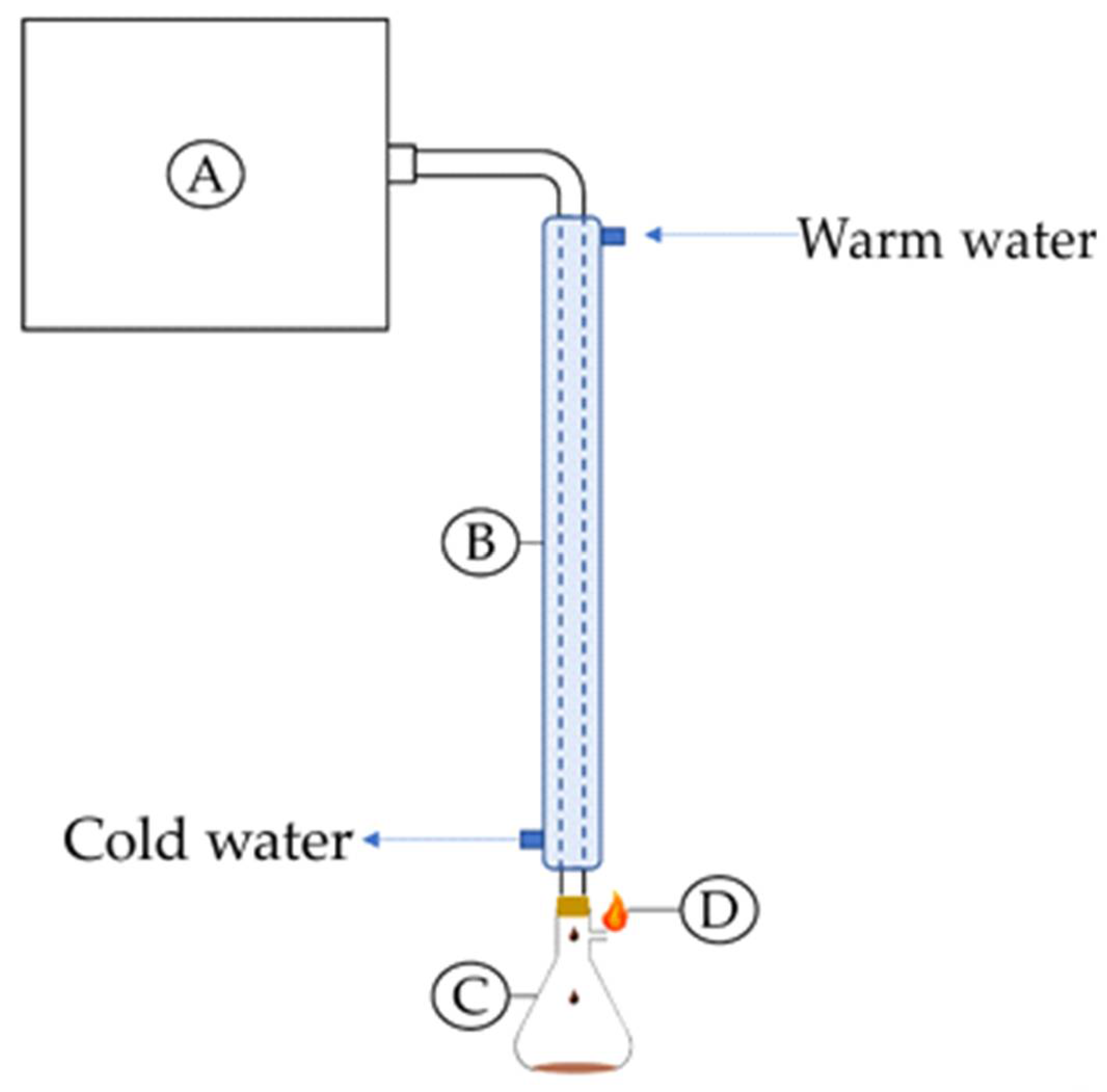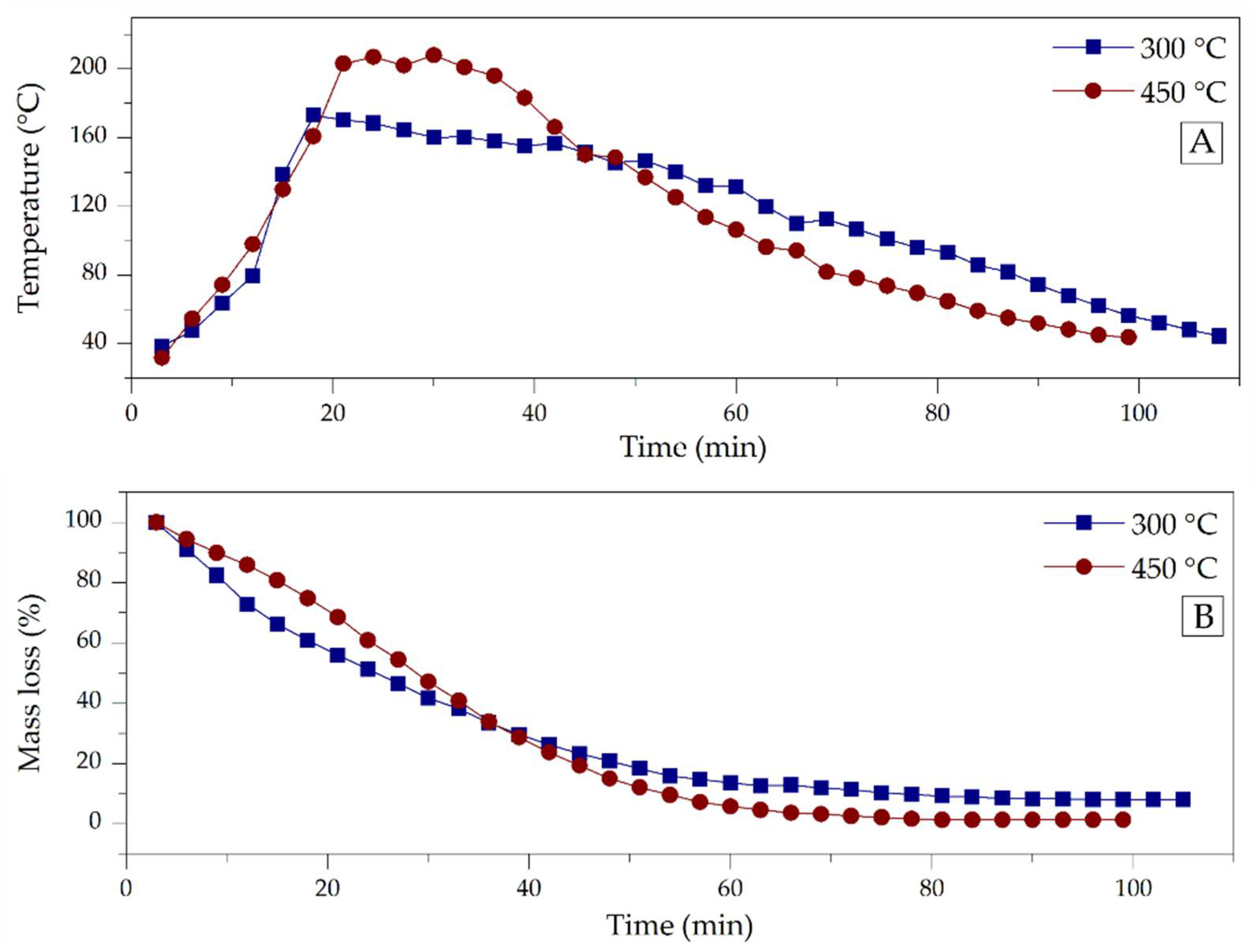Understanding the Impacts of Pyrolysis Temperature on the Energy Performance of Eucalyptus spp. Charcoal †
Abstract
:1. Introduction
2. Materials and Methods
2.1. Wood Preparation
2.2. Charcoal Production
2.3. Characterization of Charcoal
2.4. Data Analysis
3. Results
4. Discussion
5. Conclusions
Author Contributions
Funding
Institutional Review Board Statement
Informed Consent Statement
Data Availability Statement
Acknowledgments
Conflicts of Interest
References
- Food and Agriculture Organization of the United Nations, FAO. Wood Energy. Available online: http://www.fao.org/forestry/energy/en/ (accessed on 20 April 2021).
- Tvaronavičienė, M.; Baublys, J.; Raudeliūnienė, J.; Jatautaitė, D. Global Energy Consumption Peculiarities and Energy Sources: Role of Renewables. Energy Transformation Towards Sustainability; Elsevier: Amsterdam, The Netherlands, 2020; ISBN 9780128176887. [Google Scholar]
- Bassam, N. Energy Resources, Global Contribution, and Applications; Elsevier Inc.: Amsterdam, The Netherlands, 2021; Volume 2, ISBN 9780128216057. [Google Scholar]
- Norgate, T.; Haque, N.; Somerville, M.; Jahanshahi, S. Biomass as a Source of Renewable Carbon for Iron and Steelmaking. ISIJ Int. 2012, 52, 1472–1481. [Google Scholar] [CrossRef]
- Food and Agriculture Organization of the United Nations, FAO. The Charcoal Transition; FAO: Rome, Italy, 2017; ISBN 9789251096802. [Google Scholar]
- Iiyama, M.; Chenevoy, A.; Otieno, E.; Kinyanjui, T.; Ndegwa, G.; Vandenabeele, J.; Njenga, M.; Johnson, O. Achieving Sustainable Charcoal in Kenya: Harnessing the Opportunities for Cross-Sectoral Integration; World Agroforestry (ICRAF), Stockholm Environment Institute (SEI): Nairobi, Kenya, 2014; pp. 2–5. [Google Scholar]
- Jahirul, M.I.; Rasul, M.G.; Chowdhury, A.A.; Ashwath, N. Biofuels Production through Biomass Pyrolysis- A Technological Review. Energies 2012, 5, 4952–5001. [Google Scholar] [CrossRef]
- Solar, J.; de Marco, I.; Caballero, B.M.; Lopez-Urionabarrenechea, A.; Rodriguez, N.; Agirre, I.; Adrados, A. Influence of Temperature and Residence Time in the Pyrolysis of Woody Biomass Waste in a Continuous Screw Reactor. Biomass Bioenergy 2016, 95, 416–423. [Google Scholar] [CrossRef]
- Assis, M.R.; Brancheriau, L.; Napoli, A.; Trugilho, P.F. Factors Affecting the Mechanics of Carbonized Wood: Literature Review. Wood Sci. Technol. 2016, 50, 519–536. [Google Scholar] [CrossRef]
- Kan, T.; Strezov, V.; Evans, T.J. Lignocellulosic Biomass Pyrolysis: A Review of Product Properties and Effects of Pyrolysis Parameters. Renew. Sustain. Energy Rev. 2016, 57, 1126–1140. [Google Scholar] [CrossRef]
- de Oliveira, A.M.; Barreto-Garcia, P.A.B.; Alves, B.J.R.; Conceição Júnior, V.; Gama-Rodrigues, E.F. Efeito de Rotações Sucessivas de Eucalipto Na Mineralização de Nitrogênio e Carbono Do Solo e Suprimento de Nitrogênio, No Sudoeste Da Bahia, Brasil. Sci. For. 2020, 48, 1–12. [Google Scholar] [CrossRef]
- D1762-84; Standard Test Method for Chemical Analysis of Wood Charcoal. American Society for Testing and Material. ASTM International: West Conshohocken, PA, USA, 2007.
- NBR 11941; Madeira—Determinação Da Densidade Básica. Associação Brasileira de Normas Técnicas. ABNT: Rio de Janeiro, Brazil, 2003.
- NBR 6922; Carvão Vegetal—Ensaios Fisícos—Determinação Da Massa Específica Do Carvão Vegetal. Associação Brasileira de Normas Técnicas. ABNT: Rio de Janeiro, Brazil, 1981; p. 2.
- EN 14918; Determination of Calorific Value: Belim. Deutsches Institut für Normung. DIN: Berlim, Germany, 2010.
- Quirino, W.F.; Brito, J.O. Características e Índice de Combustão de Briguetes de Carvão Vegetal; Laboratório de Produtos Florestais—LPF: Brasília, Brazil, 1991; p. 19. [Google Scholar]
- Dias Júnior, A.F.; Brito, J.O.; Andrade, C.R. Granulometric Influence on the Combustion of Charcoal for Barbecue. Rev. Árvore 2015, 39, 1127–1133. [Google Scholar] [CrossRef]
- de Paula Protásio, T.; Roque Lima, M.D.; Scatolino, M.V.; Silva, A.B.; Rodrigues de Figueiredo, I.C.; Gherardi Hein, P.R.; Trugilho, P.F. Charcoal Productivity and Quality Parameters for Reliable Classification of Eucalyptus Clones from Brazilian Energy Forests. Renew. Energy 2021, 164, 34–45. [Google Scholar] [CrossRef]
- Trugilho, P.F.; Lima, J.T.; Mori, F.A.; Lino, A.L. Avaliação de Clones de Eucalyptus Para Produção de Carvão Vegetal. Cerne 2001, 7, 104–114. [Google Scholar]
- Dias Junior, A.F.; Esteves, R.P.; da Silva, Á.M.; Sousa Júnior, A.D.; Oliveira, M.P.; Brito, J.O.; Napoli, A.; Braga, B.M. Investigating the Pyrolysis Temperature to Define the Use of Charcoal. Eur. J. Wood Wood Prod. 2020, 78, 193–204. [Google Scholar] [CrossRef]
- Yang, H.; Yan, R.; Chen, H.; Lee, D.H.; Zheng, C. Characteristics of Hemicellulose, Cellulose and Lignin Pyrolysis. Fuel 2007, 86, 1781–1788. [Google Scholar] [CrossRef]
- Dias Júnior, A.F.; Pirola, L.P.; Takeshita, S.; Lana, A.Q.; Brito, J.O.; Andrade, A.M. Higroscopicity of Charcoal Produced in Differen Temperatures. Cerne 2016, 22, 423–430. [Google Scholar] [CrossRef]
- Oliveira, A.C.; de Carneiro, A.C.O.; Vital, B.R.; Almeida, W.; Pereira, B.L.C.; Cardoso, M.T. Parâmetros de Qualidade Da Madeira e Do Carvão Vegetal de Eucalyptus Pellita F. Muell. Sci. For. 2010, 38, 431–439. [Google Scholar]
- São Paulo. Resolução SAA—40, de 14 de Dezembro Da Secretaria de Agricultura e Abastecimento. Dispõe de Padrões Mínimos de Qualidade de Carvão Vegetal; São Paulo, Brazil, 2015; pp. 1–11. Available online: http://www.codeagro.agricultura.sp.gov.br/arquivos/selo/SAA%2040%20Carvao%20Vegetal%202015.pdf (accessed on 20 April 2021).
- Dias Júnior, A.F.; Anuto, R.B.; Andrade, C.R.; de Souza, N.D.; Takeshita, S.; Brito, J.O.; Nolasco, A.M. Influence of eucalyptus wood addition to urban wood waste during combustion. Cerne 2017, 23, 455–464. [Google Scholar] [CrossRef]


| TPR | VM | AS | FC | AD | BD | ED | HHV |
|---|---|---|---|---|---|---|---|
| (°C) | (%) | (%) | (%) | (kg·m−3) | (kg·m−3) | (GJ·m−3) | (MJ·kg−1) |
| 300 | 33.23 * (1.26) | 1.07 (0.01) | 65.70 (1.25) | 299.74 (21.48) | 133.86 * (2.33) | 3.58 * (0.01) | 28.25 (0.06) |
| 450 | 15.92 (1.65) | 1.11 (0.03) | 82.98 * (1.68) | 320.90 (15.27) | 105.36 (0.02) | 3.22 (0.02) | 32.00 * (0.21) |
Disclaimer/Publisher’s Note: The statements, opinions and data contained in all publications are solely those of the individual author(s) and contributor(s) and not of MDPI and/or the editor(s). MDPI and/or the editor(s) disclaim responsibility for any injury to people or property resulting from any ideas, methods, instructions or products referred to in the content. |
© 2021 by the authors. Licensee MDPI, Basel, Switzerland. This article is an open access article distributed under the terms and conditions of the Creative Commons Attribution (CC BY) license (https://creativecommons.org/licenses/by/4.0/).
Share and Cite
Pereira, A.K.S.; Júnior, D.L.; da Silva, Á.M.; de Souza, E.C.; Delatorre, F.M.; Rodrigues, B.P.; Júnior, A.F.D. Understanding the Impacts of Pyrolysis Temperature on the Energy Performance of Eucalyptus spp. Charcoal. Environ. Sci. Proc. 2022, 13, 25. https://doi.org/10.3390/IECF2021-10794
Pereira AKS, Júnior DL, da Silva ÁM, de Souza EC, Delatorre FM, Rodrigues BP, Júnior AFD. Understanding the Impacts of Pyrolysis Temperature on the Energy Performance of Eucalyptus spp. Charcoal. Environmental Sciences Proceedings. 2022; 13(1):25. https://doi.org/10.3390/IECF2021-10794
Chicago/Turabian StylePereira, Allana Katiussya Silva, Dalton Longue Júnior, Álison Moreira da Silva, Elias Costa de Souza, Fabíola Martins Delatorre, Brunela Pollastrelli Rodrigues, and Ananias Francisco Dias Júnior. 2022. "Understanding the Impacts of Pyrolysis Temperature on the Energy Performance of Eucalyptus spp. Charcoal" Environmental Sciences Proceedings 13, no. 1: 25. https://doi.org/10.3390/IECF2021-10794





